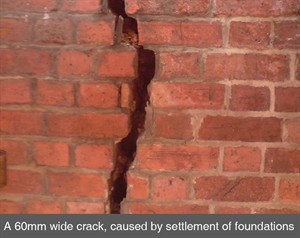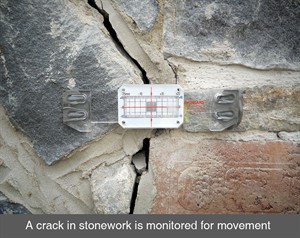Masonry Cracking
 Cracks occur quite often in masonry
buildings; many are insignificant, though equally, they can be an
indication that there is a serious structural failure in your
building. If you have any concerns, then it is important that
an expert is called to assess and identify the possible causes.
Cracks occur quite often in masonry
buildings; many are insignificant, though equally, they can be an
indication that there is a serious structural failure in your
building. If you have any concerns, then it is important that
an expert is called to assess and identify the possible causes.
There are a number of occurrences which can cause cracks in
walls. Generally, the shape, form and position of the crack
can help our experienced surveyors identify the cause of the crack,
and whether reinforcement works need to be carried out.
Causes can include:
- Thermal movement; usually results in small hairline cracks
- Settlement of foundations; can result in hairline cracks to
more serious cracks, which may require crack stitching,or underpinning
- Insufficient support for masonry - due to lintel
failure, arch or beam failure etc: can be remedied by
conventional tie bars & pattress
plates, or by more innovative crack stitching methods
- Cavity
wall tie failure; usually results in stepped cracks and bulging
and leaning walls; insufficient lateral restraint may also cause
walls to lean and bulge.

Measurement & Monitoring of Cracks
Often, it is imperative to know and understand if the movement
which has caused the crack in the masonry is still active, or if
movement has stopped. Stronghold Preservation can carry out a
measurement and monitoring survey to identify firstly if movement
is active, and secondly, the rate of movement, before any
structural repair works are carried out.
Repair of Cracks in Walls
The repair method is dependent on the problem; here, at
Stronghold Preservation, we have a range of conventional or
innovative structural stitching systems, including: Helical crack stitching
bars or Cintec Cementitious Sock Anchors
to remedy cracks in the masonry building. Generally, but not
exclusively, we tend to use Cintec anchors for stone buildings, and
helical bars for masonry brick buildings.
Our experienced surveyors and technicians can advise on the best
solution depending on the structural problem; often, an
amalgamation of more than one system is the preferred option.
As approved installers of Cintec Anchors, and crack stitching
system, we at Stronghold Preservation can provide the best solution
for the problem.
Where there is delamination of concrete or masonry buildings, or
where there is a risk of falling bricks or masonry, we can provide
a masonry netting system,
as a temporary measure, to prevent danger to the public, and to
prevent further damage to the building.
Rope Access
Here at Stronghold Preservation, we have our own IRATA trained
rope access team, which
allows us to carry out structural repairs to buildings and
structures which are not accessible by traditional methods.
We have been involved in stabilising the cliff face at Dunluce Castle, Co.
Antrim and Claridges Hotel,
London, by rope access (abseiling).